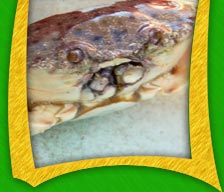|
CRUSTACEAN ANATOMY
Crustaceans like the
spiny lobster and stone crab have three distinct body parts: head,
thorax and abdomen. The head has two pairs of antennae, a pair of
eyes and three pairs of mouthparts. The appendages attach to the
thorax and the gills are located there as well. They are protected
by a tough exoskeleton which must be shed to allow the animal to
grow. Both the crab and lobster have a carapace which is a thick
dorsal shield that also helps protect the animal; the carapace usually
covers the thorax segment of the animal.
CLAWING AROUND
Stone Crabs have two large claws,
the larger of the two is called the ‘crusher claw’ while
the smaller one is called the ‘pincher
claw’. Stone Crabs have the special ability of regenerating
their large claws. This characteristic enables them to lose their
limbs easily in order to escape from predators or from tight crevices.
When a claw is broken in the correct spot, the wound will heal itself
quickly with little blood loss. But if the claw is broken in the
wrong spot, the blood loss is significant and the crab may not survive
. For a mature crab it takes about three molts or the equivalent
of three years for the claw to grow back to a legal size. The time
of re-growth can be longer or shorter depending on the size and age
of the crab.
GONE FISHIN'
There are two spiny lobster fishing seasons throughout the
year. The first is the two-day mini-season which occurs during the
last consecutive Wednesday and Thursday of July each year. The regular
season, which is open to recreational and commercial fishermen, runs
from August 6 to March 31. Typically, 1.5 to 2 million pounds of lobster
will be harvested by the recreational fishermen. The commercial fishermen
harvest an average of 6 million pounds per season, with an average
value of $20 million.
There are strict regulations in place to protect stone
crabs because of the over-fishing that occurred in the 1960s. They
are available for harvest from October 15 until May 15 only. The
claws can be taken from the crab, but it must be returned to the
water to allow for the regeneration of another claw. The claws must
be 2.75 inches long to be taken from the crab.
Resources for this article
have been provided by Wikipedia,
the US Fish and
Wildlife Service and the Florida
Fish and Wildlife Conservation Commission.
|






